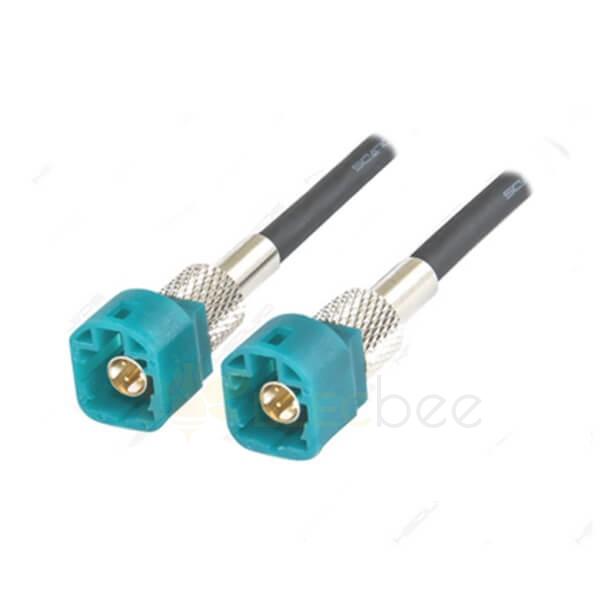High-Speed Data (HSD) connectors and cables are critical components in many modern electronic systems, including automotive, medical, and industrial applications. These connectors and cables are designed to transmit large amounts of data at high speeds, making them essential for high-performance systems. To ensure optimal performance, it's crucial to choose the right HSD Connector And Cable for your specific application. In this article, we'll go over the factors you should consider when selecting an HSD Connector And Cable.
1. Data Rate
The data rate is one of the most important factors to consider when choosing an HSD Connector And Cable. HSD connectors and cables are designed to transmit data at high speeds, and different connectors/cables have different data rate capabilities. It's crucial to select a Connector And Cable that can handle the data rate required by your applicaton. If the Connector And Cable can't handle the required data rate, it can cause data loss or signal degradation, which can lead to system failure.
2. Signal Integrity
Signal integrity is another critical factor to consider when selecting an HSD Connector And Cable. Signal integrity refers to the ability of the Connector And Cable to transmit the signal accurately without any distortion or noise. HSD connectors and cables are designed to minimize signal loss and interference, but different connectors/cables have different signal integrity capabilities. It's essential to select a Connector And Cable that can provide the required signal integrity for your application.
3. Shielding
HSD connectors and cables are often used in applications where electromagnetic interference (EMI) is a concern. EMI can cause signal interference or noise, leading to system failure. Shielding is essential to minimize EMI. Some high-speed data cables are more resistant to electromagnetic interference than others. Shielded and braided cables help prevent EMI/RFI noise from crowding the signal. Cables operating at faster speeds are also more susceptible to interference and require enhanced shielding protection. If running cables close to electrical equipment, across dirty or wet areas, or in harsh industrial environments, an EMI-shielded and insulated HSD cable is important. Different HSD connectors/cables have different shielding capabilities, and it's crucial to select a Connector And Cable with adequate shielding for your application.
4. HSD Cable And Connector Type
Different HSD Connector And Cable types are available, including coaxial, twisted pair, and differential pair. Each type has its advantages and disadvantages, and it's crucial to select the type that best suits your application. Coaxial cables are suitable for applications that require high signal integrity, while twisted pair cables are suitable for applications that require high noise immunity. Differential pair cables are suitable for applications that require both high signal integrity and high noise immunity
5. HSD Cable And Connector Termination
HSD connectors and cables are terminated in different ways, including crimping, soldering, and insulation displacement. Each termination method has its advantages and disadvantages, and it's crucial to select the method that best suits your application. Crimping is a popular termination method because it's easy to perform and provides a reliable connection. Soldering provides a more secure connection, but it's more challenging to perform. Insulation displacement is a quick and easy termination method, but it's not as reliable as crimping or soldering.
6. HSD Cable And Connector Materials
The materials used in HSD connectors and cables can affect their performance. Different materials have different electrical properties, and it's crucial to select materials that provide the required performance for your application. The most common materials used in HSD connectors and cables are copper and aluminum. Copper is an excellent conductor of electricity and is often used in high-performance applications. Aluminum is a more affordable alternative, but it's not as good a conductor as copper.

7. HSD Cable And Connector Size
The size of the HSD Connector And Cable can affect its performance and installation. Different HSD connectors/cables have different sizes, and it's crucial to select a size that best suits your application. Smaller connectors/cables are suitable for applications where space is limited, while larger connectors/cables are suitable for applications where signal integrity is critical.
8. HSD Cable And Connector Durability
How often will the cable be connected and disconnected? If frequently adding, removing, or re-configuring cables, a rugged, locking connector will reduce wear and prevent loose connections. Some HSD cables also offer 90-degree rotated connectors that provide additional strain relief. Cables with fewer connectors also minimize signal interference points between component
9. HSD Cable And Connector Manufacturer
The manufacturer of the HSD Connector And Cable can affect its quality and reliability. It's crucial to select a reputable manufacturer that produces high-quality connectors/cables. Reputable manufacturers often have strict quality control processes and use high-quality materials, ensuring that their connectors/cables perform reliably.
In conclusion, choosing the right HSD Connector And Cable for your application is critical to ensure optimal system performance. When selecting an HSD Connector And Cable, consider factors such as data rate, signal integrity, shielding, Connector And Cable type, termination method, materials, size, and manufacturer. By taking these factors into account, you can select an HSD Connector And Cable that meets the specific requirements of your application and provides reliable, high-performance data transmission.

